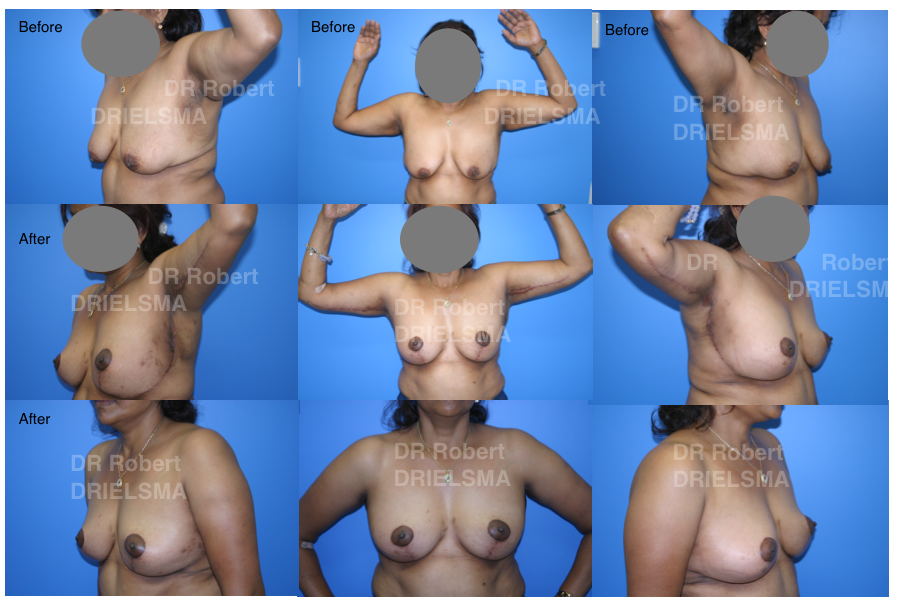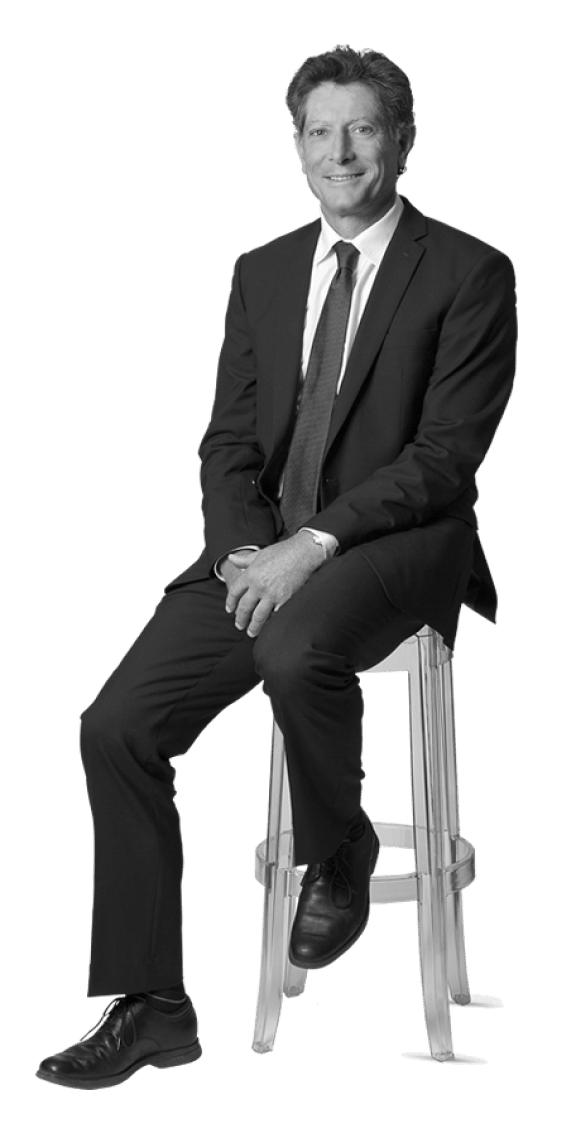An Upper Body-Lift combines three operations:
- A breast Lift (mastopexy)
- An arm lift (brachioplasty)
- A side chest lift
Dramatic weight loss typically follows bariatric surgeries such as lap-banding or gastric sleeve procedures. Further, massive weight loss can result in breast sag (ptosis) and emptiness, upper arm flabbiness (bat wings or bingo arms) and outer chest wall-axilliary skin looseness and sag.
Following massive weight loss, the usual first priority is addressing skin looseness of the lower body – a lower body-lift (circumferential lipectomy). This entails a tummy tuck (abdominoplasty) in the front and an outer thigh lift and buttock lift at the sides and back. This is also known as a circumferential or “belt” lipectomy.
Patients may also have ongoing concerns regarding skin excess and looseness of the upper body and an upper body-lift may be the next step.
An upper body-lift typically also combines a breast lift (mastopexy) with or without breast implants (mammoplasty), along with an arm-lift (brachioplasty) and outer chest wall lift.
Before and After Gallery
An Upper Body-Lift combines three operations:
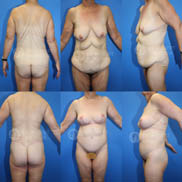
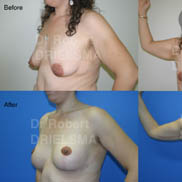
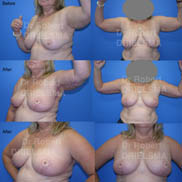
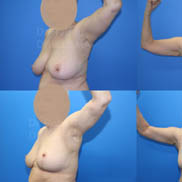
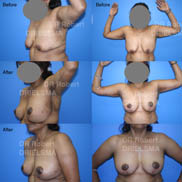
-
You are candidate for an upper body-lift if you have/are:
-
Are there any risks?
Meet our Specialist Plastic Surgeon Dr Robert Drielsma MBBS, BSc(Med), FRACS
(AHPRA MED00001073756)
Dr Drielsma is an Australian trained Specialist Plastic Surgeon with over 30 years of extensive experience in plastic surgery of the face, breasts and body. He is a fellow of the Royal Australasian College of Surgeons (FRACS), a member of the Australian Society of Plastic Surgeons (ASPS) and a member of the Australian Society of Aesthetic Plastic Surgeons (ASAPS)

-
Next Step
- Next Step : Book your Initial Consultation
- What to Bring to your Surgeon Consultation
**Individual results may vary. All surgery carries risks.
You should seek a second opinion from an equally qualified Specialist Plastic Surgeon before proceeding with surgery.
Circumferential lower body lift and breast lift by Dr Drielsma.
This patient had a full lower circumferential lipectomy otherwise known as a bodylift together with a skin only “lollipop” breast lift.
NO IMPLANTS have been used.
Post op photo taken 3 months after surgery.
Individual results may vary. All surgeries carry potential risks and complications. You should seek the opinion of a fully qualified Specialist Plastic Surgeon before proceeding with surgery. Dr Drielsma is a fully qualified Specialist Plastic Surgeon. (AHPRA - MED0001073756)
.
.
.
#breastreduction #breastlift #lollipopbreastreduction #lollipopbreastlift #internalbrasling #plasticsurgeonsydney #plasticsurgeonwagga #plasticsurgeoncanberra #plasticsurgeoncamden #bodylift #tummytuck

Breast shape naturally changes over time due to aging, gravity, and skin laxity. Many individuals experience breast ptosis (sagging), often paired with a loss of volume, resulting in a deflated or empty appearance.
If you are looking to restore shape and fullness, a breast lift using your own natural tissue may be the solution you are after. Using Dr Drielsma`s all natural lollipop breast lift without the need for breast implants can give a natural soft but perky result. This approach is particularly beneficial for individuals with sagging or droopingwith a B to D cup breast volume with no need to increase breast size.
Many patients are told they need to have breast implants to give shape. This is untrue and leads to many patients having oversized, fake looking breasts which develop breast implant complications over time.
A personalised consultation with a fully qualified Specialist Plastic Surgeon is essential to assess your goals, anatomy, and the most suitable treatment plan—ensuring realistic expectations and optimal results. Dr Drielsma is a fully qualified Specialist Plastic Surgeon.
.
.
.
#breastreduction #breastlift #bestplasticsurgeonsydney #lollipopbreastreduction #lollipopbreastlift #plasticsurgeonsydney #plasticsurgeonwagga #plasticsurgeoncanberra #plasticsurgeoncamden #bodylift #tummytuck

20 year old woman - Total Rhinoplasty. Removal of nose "bump" and refinement of nasal tip.
Post operative photos shown 3 months following surgery
Individual results may vary. All surgeries carry potential risks and complications. You should seek the opinion of a fully qualified Specialist Plastic Surgeon before proceeding with surgery. Dr Drielsma is a fully qualified Specialist Plastic Surgeon. (AHPRA - MED0001073756)
.
.
.
#breastreduction #breastlift #lollipopbreastreduction #lollipopbreastlift #internalbrasling #plasticsurgeonsydney #plasticsurgeonwagga #plasticsurgeoncanberra #plasticsurgeoncamden #bodylift #tummytuck

Understanding Breast Reduction & Lift Procedures ✨
Did you know there are different techniques for breast reduction and lift? 🤔 Let’s break down the Lollipop vs. Anchorprocedures, and why Dr. Drielsma’s signature Lollipop Breast Reduction & Lift stands out!
🔹 Lollipop Breast Reduction & Lift: This technique uses a small incision around the areola and a vertical line beneath it, creating a “lollipop” shape. It’s perfect for those looking for a lift with minimal scarring and a more youthful, natural appearance.
🔹 Anchor Breast Reduction & Lift: The traditional method, involving three incisions: around the areola, down to the crease, and along the breast fold. This is ideal for patients with more significant sagging or excess skin.
✨ Why Dr. Drielsma’s Lollipop Technique?
Dr. Drielsma’s signature Lollipop Breast Reduction & Lift combines precision and artistry, giving you stunning results with less scarring and faster recovery. The technique is perfect for those who want to reduce volume and achieve a more firm, all natural and raised breast appearance.
Interested in learning more? DM us or book a consultation today! 🩺💕
.
.
.
#BreastReduction #BreastLift #LollipopLift #AnchorLift #DrDrielsma #SignatureTechnique #PlasticSurgery #BreastAugmentation #BodyConfidence

-Natural Shape
-Natural Size
-Natural Result
No implants. No boxy breasts.
Just Dr Drielsma’s signature, minimal scarring, lollipop breast reduction.
160 grams removed from the right
200 grams removed from the left
.
.
.
Individual results will vary according to factors including genetics, age, diet and exercise. All surgery carries risks and requires a recovery period and care regime including wearing of post operative garments. More information is available from the relevant procedure page on our website. You should seek a second opinion from a Specialist Surgeon before proceeding. Dr Drielsma is a Specialist Plastic Surgeon - AHPRA Registration: MED0001073756.
.
.
.
#breastreduction #breastlift #lollipopbreastreduction #lollipopbreastlift #internalbrasling #plasticsurgeonsydney #plasticsurgeonwagga #plasticsurgeoncanberra #plasticsurgeoncamden #bodylift #tummytuck



 Before & After
Before & After



